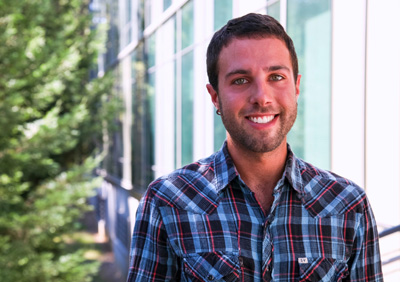Campus News
Picture this: An app for blind photographers
Grad student Dustin Adams, who works in UC Santa Cruz’s Interactive Systems for Individuals with Special Needs lab, designed a tool to recognize and describe photos.

Dustin Adams listened as one of his colleagues narrated photos of her trip to Venice, Italy.
What was remarkable was not the descriptions of the canal rides or beautiful churches, but rather that Adams’s colleague was blind and was using a mobile app the 28-year-old UC Santa Cruz grad student had designed to recognize and describe the vacation shots she had taken.
The app, which has already won two prestigious design awards, allows someone who is visually impaired to not only recognize their photos but also to organize them and even share their shots through social media.
It’s a technological accomplishment that may seem counterintuitive on its face — until, as Adams explains, not only are there are a number of famous photographers who are visually impaired but also that a Flickr group set up for blind photographers has 386 members and nearly 10,000 photos.
“I like the idea of using technology to help people do things,” Adams says.
Raised on a cattle- and hay-ranch near Huntsville, Texas, Adams had always been interested in human/computer interaction. But it wasn’t until he met UC Santa Cruz Associate Professor of Computational Media and Computer Engineering Sri Kurniawan that he found his passion. He began working in her Interactive Systems for Individuals with Special Needs lab.
The idea for his app, which he would later name VizSnap, came during a National Science Foundation-funded internship he won at IBM’s Tokyo Accessibility Research Lab in Japan.
Inspired by his group leader there, a blind accessibility researcher and IBM Fellow named Chieko Asakawa, Adams spent six to nine months programming the app, then spent more months conducting user studies and refining the technological tool.
In its current incarnation, VizSnap allows a user to make an audio recording of the environment where the photo is being taken in order to help identify the shot. It also notes date, time, and location, while permitting the photographer to give a voice memo about the captured image.
“One of the misconceptions is that if you’re blind, you don’t take photos,” says Kurniawan of Adams’s technology. “But why do we take photos? Some people say it is to remind them of when they were, say, in Paris. But many also say they take photos to show family and friends back home.”
VizSnap allows them to do both.
Available for free download, VizSnap won first prize in the design competition at the MobileHCI (Human-Computer Interaction) conference two years ago and nabbed second place at the Big Ideas @ Berkeley competition.
Adams is still refining his app and is looking for more users for a long-term study with the technology. But he believes the work he — and others in Kurniawan’s lab — are doing is important because people with disabilities are often overlooked when new technology is being developed.
“I don’t think it’s intentional,” Adams says, “but it ends up to be a form of discrimination. People are left out.”
Along with Adams’s app, other adaptive technologies are under development in Kurniawan’s lab, including a video game to help children with corrected cleft palates and lips learn to speak more clearly, a computer app that allows those with visual impairments to independently format documents, and a special glove that can ease the symptoms of those with hand tremors.
“I think this all fits in well with the ethos of UC Santa Cruz,” Adams says of the work he has done. “It (the university) does a good job of trying to include people.”